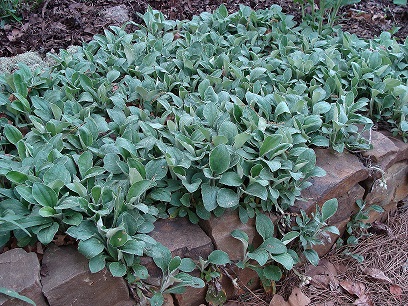Pussytoes (Antennaria parlinii) of the Asteraceae (Aster) Family, occurs throughout most of Arkansas, especially in northwestern and central portions of the state. It also occurs from Texas to the Dakotas and eastward to the Atlantic.

Emerging flowering stems among old basal leaves of pussytoes. Stems initially recumbent, then upright.
These perennial, low-growing plants are usually found in sunny to shady, dry sites including rocky slopes, open oak, hickory and pine woodlands and prairies.
Pussytoes form colonies growing from stolons (horiztonal stems above ground that root at nodes…as opposed to rhizomes which are horizontal, root-like stems underground, which can be found on some species of pussytoes outside of Arkansas). New basal leaves appear in a rosette after flowering has started and while old leaves are still present (unless unusually cold winter). Basal leaves are spoon-shaped with long petioles and three to five prominent veins from petiole to tip.
The pale green leaves have long white, tangled hairs on the upper surface and dense white, short tangled hairs on the lower surface. Leaves are about three inches long and two inches wide.
Flower stems are generally less than 12 inches tall, sparsely leafy and woolly. Stem (cauline) leaves are sparse and alternate with a linear shape and a point at the tip. Upper and lower surfaces of stem leaves are woolly.
Pussytoes bloom in early spring with small whitish flowers crowded into a tight, terminal fuzzy cluster (corymb), less than ½ inch wide, of four to twelve flower heads giving the appearance of a cat’s paw, hence the common name.
Flower heads are composed of 20 to 100 tubular florets supported in a receptacle of small leaf-like bracts (involucre). Male and female flowers grow on separate plants (dioecious). Male flowers are on shorter stems than female flowers and male flower clusters are rounded. Female flowers are on taller stems and clusters are more elongated with pink to red styles extended above the florets. Seeds (achenes) are equipped with hairs for wind dispersal. Seeds disperse quickly and the stems wither by early summer.
Pussytoes are an excellent choice for native plant gardens with partial sun and well drained sandy/rocky soil. Plants provide an attractive ground cover by adding texture and color. It’s also a host plant for American lady butterflies (Vanessa virginiensis) and a nectar plant for various other butterflies and moths. (Photos taken in a garden setting.)

Pussytoes flowers are a nectar source for various butterflies and moths, such as juniper hairstreak and grapevine epimenis.
Two other species of pussytoes grow in Arkansas. Antennaria plantaginifolia, also generally just called ‘pussytoes’, looks nearly identical to A. parlinii and is dificult to distinguish. It differs primarily in chromosome numbers and flower size (on the order of a few milimeters). Antennaria neglecta (field pussytoes) has leaves with a single vein and is rare in Arkansas, restricted to tallgrass prairies in the northwestern part of the state but also known from one historic record from the Grand Prairie of eastern Arkansas.
Article and photos by Sid Vogelpohl, ANPS member





